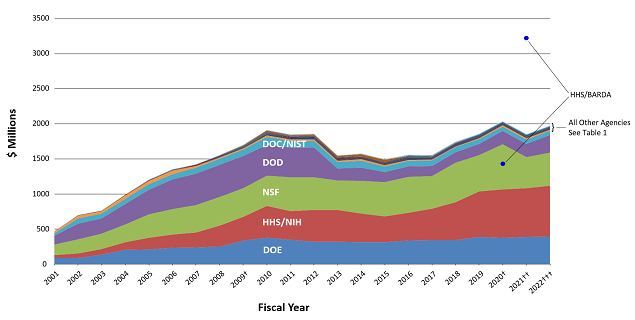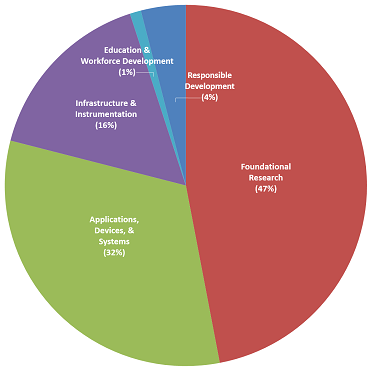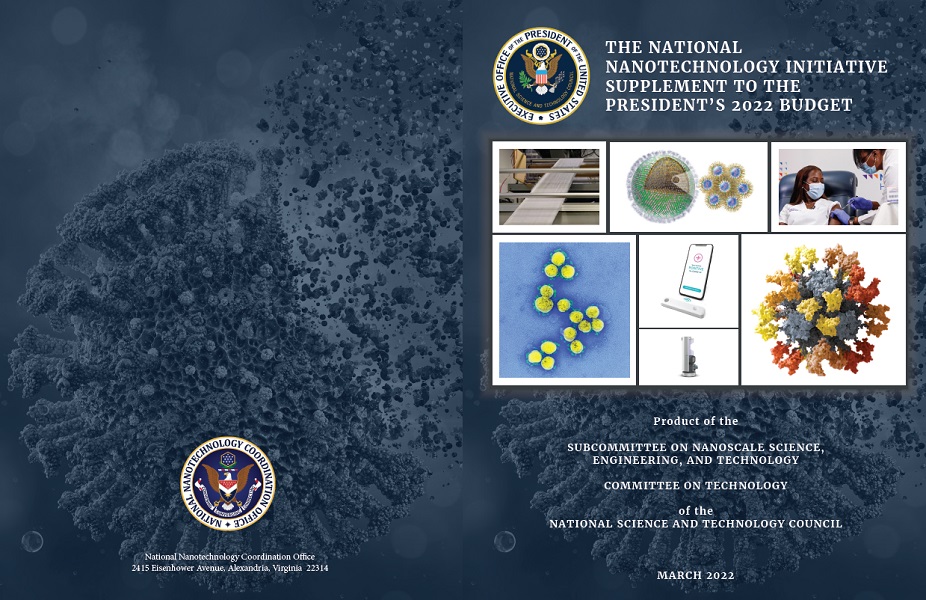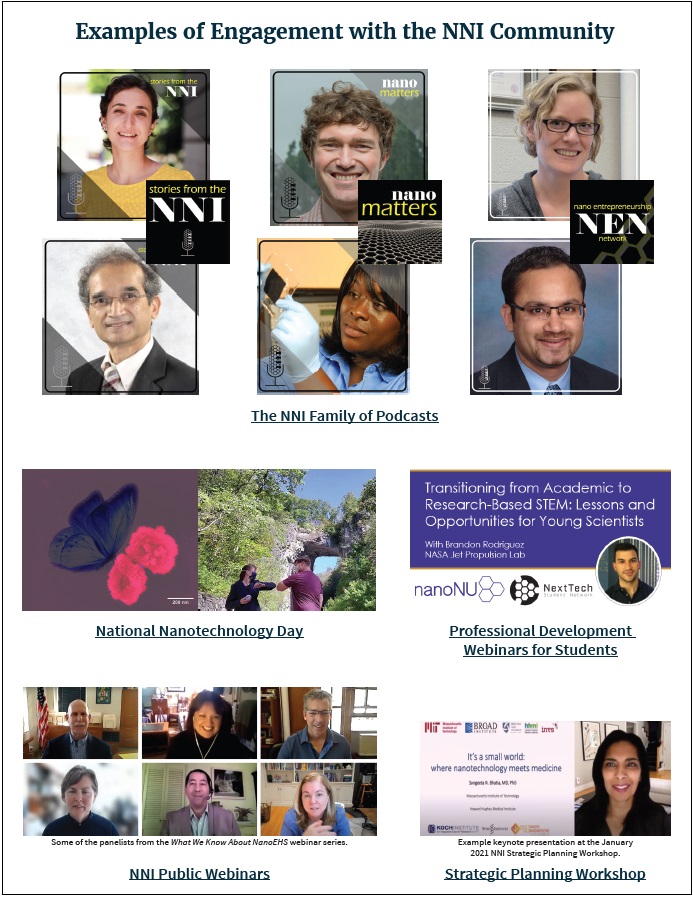NNI Supplement to the President’s 2022 Budget
This document is a supplement to the President’s 2022 Budget request and serves as the Annual Report for the National Nanotechnology Initiative (NNI), called for under the provisions of the 21st Century Nanotechnology Research and Development Act (15 USC §7501). The report also addresses the requirement for Department of Defense reporting on its nanotechnology investments, per 10 USC §2358.
The President’s 2022 Budget requests $1.98 billion for the NNI, with a continued investment in the foundational research that will fuel the discoveries necessary to advance industries of the future and address world challenges. Cumulatively totaling over $38 billion (including the 2022 request), NNI investments support research to understand matter at the nanoscale and to translate this knowledge into technological breakthroughs that benefit the American people.
 The President’s 2022 Budget supports nanoscale science, engineering, and technology R&D at 11 agencies. See the graph above for funding trends since the inception of the NNI. The NNI Supplement to the President’s 2022 Budget documents progress of the NNI participating agencies in addressing the goals and objectives of the NNI. As called for in the 21st Century Nanotechnology Research and Development Act, NNI investments are categorized by Program Component Area (PCA). The PCA breakdown for the 2022 Budget can be seen in the pie chart on the left.
The President’s 2022 Budget supports nanoscale science, engineering, and technology R&D at 11 agencies. See the graph above for funding trends since the inception of the NNI. The NNI Supplement to the President’s 2022 Budget documents progress of the NNI participating agencies in addressing the goals and objectives of the NNI. As called for in the 21st Century Nanotechnology Research and Development Act, NNI investments are categorized by Program Component Area (PCA). The PCA breakdown for the 2022 Budget can be seen in the pie chart on the left.

About the cover image (above)
Each year’s NNI Supplement to the President’s Budget features cover images illustrating recent developments in nanotechnology stemming from NNI activities that have the potential to make major contributions to national priorities.
This year’s cover is a collage of images highlighting the role of nanotechnology in the coordinated U.S. Government effort to fight the COVID-19 pandemic. Top left: A roll of N95 filter material made and studied at the Department of Energy (DOE) Oak Ridge National Laboratory (ORNL) to determine efficiency against the SARS-CoV-2 virus. The research was transitioned by industrial partners, supplying millions of masks throughout the United States. Image credit: DOE/ORNL; funded by DOE and the Department of Health and Human Services (HHS). Top center: Artist’s (computerized) rendition of lipid nanoparticles used in the messenger RNA (mRNA) vaccine formulations to safely and efficiently deliver the fragile mRNA inside cells. Image credit: Genevant Sciences. Top right: Photograph of the first person to be vaccinated against SARS-CoV-2 in the United States using an mRNA-lipid nanoparticle vaccine, on December 14, 2020, less than a year after the SARS-CoV-2 virus was sequenced. Image credit: Northwell Health; funded in part by HHS/Biomedical Advanced Research and Development Authority. Bottom left: Transmission electron micrograph of SARS-CoV-2 virus particles, isolated from a patient. Image credit: captured and color-enhanced at the National Institutes of Health (NIH)/National Institute of Allergy and Infectious Diseases (NIAID) Integrated Research Facility; funded by NIH/NIAID. Center: A quantum-dot-based digital fluorescence immunoassay antigen home COVID-19 test, one of the many nanotechnology-enabled SARS-CoV-2 tests that were developed quickly after the onset of the pandemic. Image credit: Ellume; funded in part by the NIH Rapid Acceleration of Diagnostics (RADx) Initiative. Bottom center: A commercial nanotechnology-enabled air purifier that is FDA-cleared for the destruction of viruses and bacteria. Advanced filters are a critical tool for mitigating the spread of infection. Image credit: Molekule; funded in part by the Environmental Protection Agency. Bottom right: Computer-generated illustration of a nanoparticle (gray) holding several different versions of the viral spike protein. The different colors represent a spike protein from a different coronavirus. As more strains of SARS-CoV-2 emerge, scientists are working towards creating a pan-coronavirus vaccine that can protect against many coronavirus variants, even ones that have not emerged yet, at the same time. Image credit: (Illustration) V. Altounian/Science; (Data) David Veesler/University of Washington. From Cohen, Science, 15 April 2021, DOI: 10.1126/science.abi9939. Reprinted with permission from AAAS; funded by DOE and NIH. Background image on both front and back outside covers: Computer-generated illustration of a SARS-CoV-2 viron being destroyed. Image credit: Shutterstock.

About the inside back cover (above)
Images illustrate examples of NNI outreach activities. The NNI promotes public outreach to students, teachers, the general public, and the NNI community through:
Top – The NNI family of podcasts (nano.gov/podcasts)
- Stories from the NNI (left) – experts share their perspectives on advances that have been made and future prospects of nanotechnology.
- Nano Matters (center) – explores specific examples of nanotechnology and how it impacts everyday life.
- Nano Entrepreneurship Network (NEN) (right) – brings new and seasoned entrepreneurs together with the people and resources available to support them and highlights best practices, resources, and advice from entrepreneurs.
Center
- National Nanotechnology Day on October 9 (left, nano.gov/nationalnanotechnologyday).
- Professional Development Webinars for Students (right, nexttechnetwork.org/archived-webinars).
Bottom
- Webinars to share information with the general public and the nanotechnology research and development community (left, nano.gov/PublicWebinars).
- 2021 NNI Strategic Planning Workshop (right, nano.gov/2021stakeholderworkshop).




